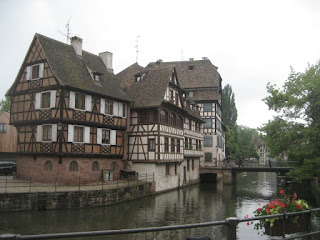
I just thought of writing a “tribute” to each country at the end of each visit. Since my visits to Portugal and Spain were weeks ago, let me start with France, where I am leaving as I write.
I have been in France for 3.5 weeks, longer than I have been in any non-residence country. Furthermore, I have visited France more than any other country. I have also traveled to every region in France, minus the center and Corsica. What about France that keeps on drawing me back? I did not realize how much I missed this country until just after I arrived.
I am amazed at the cultural, culinary and geographic diversity in a country the size of Texas. Every region is unique in its own way. Haute Savoie is known for its mountains and lakes whereas Cote d’Azur is known for its beaches. Alsatian culture has a strong German influence whereas Brittany has its own distinct culture.
The food of course is in a class of its own. The gastronomy ranges from haute cuisine dishes such as escargots, boeuf Bourguignon and magret de Canard. The various fruit tarts and chocolate cakes are to die for! And I have come to love the “holy trinity” of French cuisine--bread, cheese and wine. I simply cannot live without them! From baguettes to croissants, chevre to Camembert and Bordeaux to Burgundy, these are some of the finest (and affordable) pleasures in life!
Another aspect of French life I have grown to enjoy is its culture. Someone mentioned to me that France has a culture of culture. Now I understand why. Every level of government--national, regional, departmental, city--has a cultural ministry/department. These institutions are funded by the taxpayers (which I would gladly pay if I could; it is better use of funds rather than for bombs). Thus, there is a huge emphasis on providing cultural events, both fee and free, to its residents. Every city/town I visited had flyers advertising festivals, concerts, theatre, cinema, expositions and dance. One simply cannot get bored in France!
I would also like to comment on what’s on the screen, notably French TV and cinema. I didn’t get a chance to watch much TV (one reason is that most of my hosts did not watch TV, which is great!). However, I can say that public TV broadcasts high-quality documentaries often. Furthermore, there exists a French/German channel, Arte, that showcases cultural happenings. French cinema, in my opinion, is also of a higher quality than Hollywood. The cinematography may be simple, but French films provide more food for thought in its portrayal of daily life.
I was also surprised at the love of reading that the French display. It appears that a substantial portion of the population enjoy reading books for fun (and it is not only the upper classes or college-educated folks). Just observe the number of book fairs and stores (almost all mom-and-pop) there are. This helps to create a very educated and aware population.
Thus, the combination of haute cuisine and haute culture has created a society where it is intriguing and fun to live. This is plenty of room for spontaneity and creativity in French society. Living in France is like being part of a beautiful tapestry. Look no further than the multi-hour, multi-course meals; the endless conversations at a café; tasting and shopping at an outdoor market; admiring the displays at a mom-and-pop florist; the aimless wandering down alleys in search of art; staring in awe at the neo-classical buildings; the sound of the beautiful language; the buttery smell of a croissant as one enters a boulangerie; the taste of Brie as it melts in one’s mouth; the sight of an artistic display of cakes at a patisserie; and of course, the unforgettable first bite into that fresh, crunchy baguette.
Lastly, let me talk about the French people. Yes, there are those rude Parisians who ignore you as a tourist and those who snarl at you when you ask them, parlez vous Anglais? However, I have found the French to be a very polite people in general. One ubiquitous example is saying bonjour and au revoir every time one enters or leaves a store or museum or institution. I have also been blessed with the kindness and generosity of my CouchSurfing hosts. They have taught me many things about France and have shared their culture with me. This trip would not have been possible without them (and I mean ALL of the CouchSurfers), so I thank all of you!
Thus, it is with sadness that I bid farewell to France. I am already feeling nostalgic, especially for the fresh baguettes, croissants and pains au chocolat. I will definitely be back in the future, only this time, hopefully with someone whom I can share my experiences with.


































